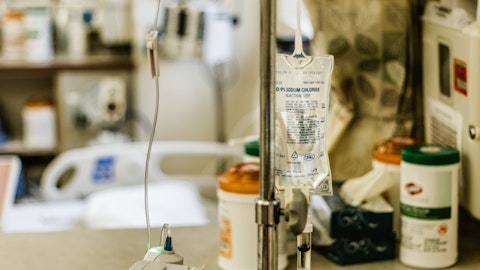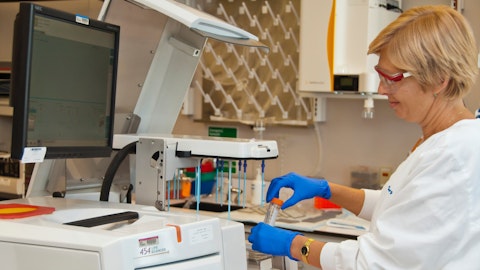Cerevel Therapeutics Holdings, Inc. (NASDAQ:CERE) Q3 2023 Earnings Call Transcript November 1, 2023
Cerevel Therapeutics Holdings, Inc. beats earnings expectations. Reported EPS is $-0.61, expectations were $-0.63.
Operator: Good morning and welcome to the Cerevel Therapeutics Third Quarter Financial Results Conference call. At this time, all participants are in listen-only mode. Later, you will have the opportunity to ask questions during the Q&A portion of the call. Please note that this call may be recorded. I will now hand the call over to Matt Calistri, Vice President of Investor Relations.
Matt Calistri: Thank you. Good morning, everyone. We appreciate you joining us for our third quarter 2023 earnings call. On today’s call, you’ll be hearing from Ron Renaud, our President and Chief Executive Officer; Dr. Ray Sanchez, our Chief Medical Officer; Dr. John Renger, our Chief Scientific Officer; and Dr. Susan Altschuller, our Chief Financial Officer. During our call today, please refer to our press release from this morning, detailing our third quarter 2023 financial performance, as well as our updated corporate presentation, both of which are available on our website. I would like to remind you that we will be making forward-looking statements that reflect our current views related to, among other things, the potential attributes and benefits of our product candidates and the format and timing of our product development activities and clinical trials.

A medical professional holding vials of biotechnology therapeutic candidate.
We strongly encourage you to review the information that we file with the SEC regarding specific risks and uncertainties. I will now hand the call over to Ron Renaud, President and CEO of Cerevel, to provide an overview of our achievements and outlook.
Ron Renaud: Thanks, Matt, and good morning, everyone, and thank you for joining us for our third quarter 2023 business results call. I’m pleased to be with all of you today to review our third quarter results and to discuss how we’re preparing for what we expect will be an exciting 2024. Let me start with some high-level thoughts on how the management team is thinking about and planning for the future of Cerevel. To begin, we believe this organization has one of the most robust neuroscience pipelines in the industry. And next year will be a pivotal one for Cerevel, as we look forward to multiple mid and late-stage readouts across three different assets and three different indications. Our recent capital raise significantly bolstered the balance sheet, extending our runway into 2026, well over 12 months beyond all of our expected data readouts next year.
As an organization, we have laser focused on execution and maximizing the value creation opportunities for each of our lead assets. Our ongoing clinical trials are progressing well, and we expect to deliver data for tavapadon, darigabat and emraclidine on the timelines we laid out last quarter. We are planning for success and proactively preparing to potentially file two NDAs in 2025 for tavapadon and emraclidine if data are positive. Furthermore, we are diligently exploring lifecycle opportunities for our lead programs and other indications. Let me now provide an overview of our lead programs. Emraclidine, our M4-selective positive allosteric modulator, or PAM, is currently in development for schizophrenia and Alzheimer’s disease psychosis as a once daily medicine without the need for titration.
Emraclidine is a potential next-generation antipsychotic with a novel mechanism of action that targets the M4 pathway. By selectively targeting M4, we believe emraclidine may reduce psychotic symptoms without challenging side effects of current antipsychotics. Our two potentially registrational trials, EMPOWER-1 and EMPOWER-2, are enrolling well and we expect data to read out in the second half of 2024. We are excited about the potential of emraclidine and the benefit it may bring to patients with schizophrenia who have not seen innovation in decades. Moving to tavapadon, the first D1/D5 partial agonist in development for the treatment of Parkinson’s disease, we expect our TEMPO-3 adjunctive trial to be our first data readout in the first half of 2024, with the TEMPO-1 and TEMPO-2 monotherapy readouts coming in the second half of the year.
Building on our excitement for this program, we are pleased to announce that we will host a tavapadon investor webcast on December 11th, during which we will explore this novel mechanism and its potential to address patient needs in greater depth. We believe there is a significant opportunity in Parkinson’s disease to deliver sustained motor control with a favorable side effect profile. And finally, let me turn to darigabat, our selective Alpha 2/3/5 GABAA PAM currently in development for both focal epilepsy and panic disorder. As we recognize Epilepsy Awareness Month in November and the 3.4 million people living with epilepsy in the United States, we are hopeful that we can bring forward a new treatment option for people living with this difficult disease.
Our Phase II realized trial in focal epilepsy to be our second readout of 2024 coming mid-year. We’ve also initiated our ADAPT trial, a Phase II proof-of-concept trial in panic disorder. Behind our mid to late-stage pipeline is an innovative discovery engine that is focused on bringing forward additional novel mechanisms to address neuroscience diseases. And we look forward to providing greater detail on those programs, including our kappa opioid receptor antagonist, as we make further progress. I’m quite excited about all that we’re doing here at Cerevel and all that is to come for our pipeline and the potential benefits we hope to bring to patients. We are well positioned as we go into 2024 to truly transform what is possible in neuroscience.
With that, I’ll now turn the call over to Dr. Ray Sanchez, our Chief Medical Officer, to provide some added color about our lead programs. Ray?
Ray Sanchez: Thank you, Ron, and good morning, everyone. I want to echo Ron’s sentiments about the excitement around our pipeline. As a former clinician, I can tell you that I am energized by the potential we have here at Cerevel to make a meaningful difference in the lives of patients with neuroscience diseases. Beginning with emraclidine, our EMPOWER program is advancing and data are expected in the second half of 2024. Preserving data quality while mitigating placebo response risk remains the utmost priority for these trials and we are pleased with our recent efforts to reinvigorate enrollment. As a reminder, EMPOWER-1 and EMPOWER-2 are two adequately powered, three-arm trials that include adults living with schizophrenia and experiencing an acute exacerbation of psychotic symptoms.
We designed these trials to potentially meet the criteria necessary to serve as pivotal trials based on what we expect the FDA will evaluate in a registrational package. We’re also enrolling our 52-week open-label safety extension trial, EMPOWER-3, and prioritizing the completion of non-clinical and clinical pharmacology studies to accelerate a potential registrational package for emraclidine in schizophrenia. We believe emraclidine has tremendous potential in other disease areas and plans for further development are underway. In Alzheimer’s disease psychosis or ADP, our Phase 1 health elderly volunteer trial is ongoing and the results of this trial will guide our clinical development plan as we advance this important indication with a substantial unmet need.
Turning now to tavapadon, our D1/D5 partial agonist in Parkinson’s disease. Our Phase 3 trials, known collectively as the TEMPO trials, are ongoing along with the corresponding open label extension in which we are encouraged by a greater than 90% rollover rate. We expect data for TEMPO 3 in the first half of 2024, with data for TEMPO-1 and TEMPO-2 coming in the second half of 2024. We look forward to walking you through the scientific rationale and prior data for tavapadon, as well as its clinical potential during our investor event in December. With darigabat, our selective GABAA PAM, we believe there is potential for both anti-epileptic and anxiolytic activity comparable to benzodiazepines with an improved side effect profile. Unlike benzodiazepines, which are only used for acute episodes due to tolerability, abuse potential and other debilitating side effects, darigabat’s novel mechanism of action and anticipated favorable tolerability profile provide the potential for chronic dosing.
We expect results from our Phase II realized trial in focal epilepsy in mid-year 2024, and we are encouraged by a continued high roll-over rate into the realized open label extension. Beyond focal epilepsy, our ADAPT Phase II trial in panic disorder is currently underway. A new drug has not been approved in panic disorder in nearly 20 years, and we are excited about the potential of providing darigabat as a daily chronic therapy to patients in need. Cerevel’s mid to late stage pipeline has the potential to bring forward numerous treatments to address some of the most devastating neuroscience diseases, and I am so proud of the team that is working diligently to make the potential — this potential, a reality. With that let me turn it over to Dr. John Renger, our Chief Scientific Officer, to provide an update on our early-stage portfolio.
John?
John Renger: Thank you, Ray, and good morning, everyone. I’m very pleased with the progress we’ve made in discovery research and early clinical development here at Cerevel. Today, I’d like to focus on our kappa opioid receptor antagonist or KORA program, also known as CVL-354. We have completed both our single and multiple ascending dose trials, in which CVL-354 has been generally well tolerated. Further, we currently believe we will be able to interrogate a range of receptor occupancies in both the kappa and Mu opioid receptors. We believe and anticipate we’ll be able to explore multiple indications of interest, such as major depressive disorder and substance use disorder. Our ongoing Phase I PET receptor occupancy trial will clarify both kappa and Mu receptor PET tracer displacement to further characterize selectivity across the compound exposures.
We are encouraged by the potential impact of this asset and look forward to providing more updates in our plans in the near future. Beyond KORA, we have a growing number of programs, some initiated within our labs and exclusively developed here at Cerevel, which we continue to progress, including our M4-selective agonist, a PDE4D-sparing antagonist, and a selective TMM-175 potentiator program. We will provide further updates and plans for these specific programs as appropriate. With that, I’m going to turn it over to our Chief Financial Officer, Dr. Susan Altschuller, to review our financial performance for the third quarter. Susan?
Susan Altschuller: Thank you, John. Turning to our financials, in October we opportunistically bolstered our balance sheet with a $499 million capital raise, providing strong validation of Cerevel’s potential from both new and existing high-quality investors. This additional capital, along with the roughly $758 million in cash, cash equivalents and marketable securities we ended the third quarter with, will support our operations into 2026. Turning to the third quarter of 2023. Operating expenses were approximately $111 million, comprised of $85 million of research and development expenses and $26 million of general and administrative expenses. Looking forward, our financial strength enabled us to focus on execution and provide optionality to maximize the value of our pipeline.
That said, we will take a disciplined approach to resource allocation as we further build our pipeline, advance our lead assets, and prepare for two potential NDA filings in parallel. With that, I will hand the call back over to Ron for his concluding remarks.
Ron Renaud: Thank you, Susan. At Cerevel, we believe we have an unparalleled pipeline in neuroscience. With multiple mid and late-stage readouts across three different assets expected next year, and a balance sheet that provides us with cash runway into 2026, we are focused and aligned on executing our trials, delivering high quality data next year and as Susan mentioned, preparing for two potential NDA filings. These are exciting times at Cerevel and I’m so proud to be leading this organization. I want to offer my sincere appreciation to all of our employees who work tirelessly every day to deliver on Cerevel’s mission. And I also want to thank our investigators and participants in our clinical trials, without whom none of this — none of what we seek to achieve would be possible. With that, let’s open the call for questions.
See also 11 Best Military Drone Stocks To Invest In and 16 Biggest Lab Grown Meat Companies in 2023.
Q&A Session
Follow Ceres Inc. (NASDAQ:CERE)
Follow Ceres Inc. (NASDAQ:CERE)
Operator: [Operator Instructions] And our first question comes from Michael Yee of Jefferies.
Michael Yee: Hey, guys. Good morning, and thanks for the question, and thanks for the updates, Ron. I know everyone’s focused on execution. Two questions. First, on emraclidine, obviously since last quarter, there was some concern about some of the timeline changes. Can you maybe just describe what initiatives give you the confidence that things are progressing on time and specifically, maybe for the team, what the right patients are, the right site selections are, that give you the confidence on executing on that enrollment? The second question is on epilepsy. There’s actually a bunch of competitor readouts happening and maybe you could help us understand about the placebo arms and what things you’re integrating into your study that might help us give us confidence here because that has historically been an issue and I know that’s a concern for others as well? Thank you.
Ron Renaud: Yeah, sure. So let me take the first part of your first question and I’ll let Ray address the second part in terms of site selection for emraclidine and then the placebo work on our epilepsy studies. So look, as we mentioned last quarter, we were focused on trying to address the challenges that we saw with some of the enrollment issues that we had. And look, we’re doing that with boots on the ground. I’ve spent time at sites with Ray and the team and the leader of our clin-ops and clinical development groups and really working with the sites to see what’s going on. And I think we’re quite pleased with the progress that we’ve seen so far. And that’s why we can stand by the guidance that we’ve given here in the quarter.
That all said, our focus will always remain on ensuring the quality of the data, and I think that gets to the second part of the question. We’re going to maintain — continue to maintain rigorous site selection and focus on our placebo variability reduction strategies. But I’ll let Ray address how we think about the sites and how we think about all of those things as we continue to make progress here and also talk about our placebo group in the epilepsy studies.
Ray Sanchez: Thank you, Michael, and good morning to you. So, as you know, Michael, as I historically define, what does a good site look like? And it’s really the access to the right patients and having good, solid raters. And that really determines, for the most part, the success of the trial. So that’s what we have been achieving and are continuing to try to achieve. But if you look at when we started the emraclidine trials, they started quite robustly for the first year, and then the momentum slowed down in the spring of this year. What we’ve learned is how to manage the competitive landscape a bit more effectively. And to that end, we’re seeing increased momentum in our enrollment without, as Ron mentioned, diluting the data quality in any way.
So again, having very close communication with the sites, ensuring that the radar recertifications occur frequently and continuing that communication ensures us that we have the greatest likelihood of success moving forward. In terms of epilepsy and the placebo response, as you know that we are seeing placebo response in indications like spinal cerebellar ataxia and epilepsy, and that would — surprises many, but we are also taking the same aggressive approach and dedicated approach to mitigating the placebo response in our focal humps and epilepsy trial by having placebo mitigation protocols at each site. But also it’s about patient selection, making sure that the right patient profile is included in these trials, and really monitoring the data — the blinded data, to ensure the quality is there.
So all taken together, really the approach we’re taking to help epilepsy to reduce placebo response is really the same approach we’ve taken to all our trials to reduce placebo response and we’re confident that we’re positioning these trials for the greatest likelihood of success.
Michael Yee: Thank you, guys.
Operator: Thank you. One moment for our next question. And our next question comes from Paul Matteis of Stifel.
Paul Matteis: Great. Thanks so much, and congrats on the progress. I honestly wanted to ask a really similar question on emraclidine, and that is related to this recent TAR-1 setback and the implications of that. I guess when you look at that data and the huge placebo response they saw and anything else within those results, what sort of metrics are you tracking specifically on a blinded basis in the emraclidine studies beyond the obvious, like just change in PANSS, that, I guess, today give you confidence that you’re getting the patient insight quality that you intended or hoped to? And then on the kappa program, I wanted to ask a quick question for John, just navacaprant and aticaprant both cite really high selectivity for kappa over Mu. What’s behind your thesis that Mu might actually contribute to efficacy in some of the conditions that you plan on pursuing? Thanks so much.
Ron Renaud: Yeah. So, I’ll let Ray take the first part.
Ray Sanchez: So, Paul, good morning. Good question. So, we review the data on a monthly basis and sometimes more frequently, but it’s blinded. So really in terms of data quality, we want to ensure that all of the parameters that we’re assessing are correct and that they’re not conflicting. And so if that occurs, we obviously intervene at the site level to make sure that the raters are doing what they need to do or they need to have a refresher and that validation, of course, occurs frequently with the raters. In terms of having the confidence that we’re mitigating that placebo response, it’s really around the measures that I mentioned earlier in Michael’s question, in terms of looking at the right patients and how do we do that.
We have an independent committee that really looks at the patient qualifications to ensure that they meet the criteria for the profile that needs to occur for them to be enrolled in the trials. So — and then we have a placebo protocol at each site that allows us to standardize the way we actually approach each patient at every site to increase the likelihood of success and mitigate that placebo response. So really we’ve taken the learnings from so many years as well as the advice from key advisors who understand placebo response and have infused them into our program. So we’re confident that we’re taking all measures to ensure that, that placebo response is mitigated. We’re also limiting the number of countries, limiting the number of sites, all which contribute to placebo response.
If you look at the trials that you’ve mentioned, the recent trial that, over six countries, over 35 sites in those trials, and so all of that contributes to variability, everything that we’re trying to minimize to ensure the greatest likelihood of success.
John Renger: Good morning, Paul, and thanks for the question on the kappa opioid receptor antagonist. So, yeah, to your question about what does Mu provide in terms of potential therapeutic benefit indications. And so as an example, what I would do is point to opioid withdrawal syndrome patients. And so If you think about what it is you want to achieve potentially with our compound with our profile, what we can do is we can go through a receptor occupancy range at kappa, where we can have selectivity to kappa. But if we continue to go up the receptor occupancy curve and exposure curves, we can bring in Mu. And so why does that provide something to us that seems exciting? It’s because what you can get is a therapeutic benefit from kappa, and what we believe the potential there is to reduce things like the [indiscernible] statement data that you see in the preclinical models, where you can remove some of the things that would cause relapse in patients that are undergoing withdrawal or undergoing abstinence from use of opioids.



